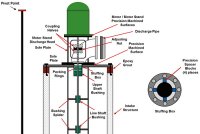The power generation industry uses high-flow, low-head vertical pumps for circulating water in both fossil and nuclear power plants. Many of these plants are approaching 40 years old and require equipment refurbishment or component replacement. One specific component that has been a major topic of discussion is the circulating water pump.
The circulating water pump is critical in any fossil or nuclear power generation plant, providing water to and through the condenser for cooling. The water may be supplied from a lake, river or ocean. Subject pumps typically have a flow rate in excess of 100,000 gallons per minute (gpm) at a relatively low head of 28 to 40 feet.
Circulating water pumps, motors and intake structures experience substantial abuse, because the operating procedure requires a 90 percent or fully closed discharge valve during startup and shutdown.
The power industry is in the midst of massive changes, and utilities are struggling to adapt. Renewable power generation, Clean Air Act, Clean Water Act and 316B (an addendum to the Clean Water Act that requires all new and existing power plants to convert to closed-loop cooling) regulations are forcing power generators to focus heavily on uptime, availability and reliability. A relatively low-cost measure to address these concerns is proper installation of critical systems such as circulating water pumps.
Pump reliability begins with proper installation, which means perfectly plumb and level as defined in this procedure. If the entire pump/motor baseplate is not plumb and level, the rotating components (above the wet end) may contact the stationary components.
Think of the pump and motor rotating components as a solid shaft from the motor thrust bearing, motor rotor and pump shaft down to the impeller. This entire rotating assembly pivots off the motor thrust bearing (see Figure 1). If the pump is not installed perfectly level and plumb, the impeller will attempt to center itself in the volute, while the motor and pump shaft rides against the motor sleeve bearing, upper bushing and line shaft bushings.
The pump bushings are not true bearings but rather rotor guides with a large (compared with the true hydrodynamic bearing in the motor) clearance between the rotor journal and the shaft. A true hydrodynamic bearing typically has 0.004-inch running clearance (one thousand per inch of shaft), while a guide bushing may have three to four times that amount with no ability to sustain a hydrodynamic loading.
Vertical circulating water pumps can be either pullout or non-pullout design. In a pullout design, the inner element of the pump can be removed for maintenance, leaving the suction bell, column, discharge elbow and discharge piping in place. A non-pullout design requires removal of the entire pump. This installation procedure addresses both configurations.
Cementitious grout is old technology and does not provide the bonding (chemical and mechanical) required to achieve a monolithic design. Epoxy grouting is the grout material of choice for both new and existing repairs or upgrades. While epoxy grout may cost more than other materials, it is the media of choice because of the stress that the pump and system experience during startup and shutdown.
Proper installation begins with the sole plate, which is the foundation for the pump. A poorly installed foundation will result in premature failure. Prior to installation, the bottom of the sole plate should be grit-blasted to a white metal finish and painted with epoxy primer then installed flat and level within 0.002 inches overall using leveling bolts. Allow a minimum 3 to 6 inches of clearance between the concrete intake structure and the sole plate for epoxy grout.
Steps for Successful Installation
- Sole plate must be flat and level within 0.002 inches. Use precision straight-edge, machinist level and feeler gauge.
- Motor stand (discharge head) must be flat and level within 0.002 inches (two places) between the motor stand and sole plate and the motor stand and motor.Use the same procedure as step one.
- Stuffing box should be concentric to motor stand.
- Check for soft foot motor stand to sole plate using dial indicator. This should require minimal shimming.
- Motor-to-motor mounting face should be flat within 0.002 inches. The motor shaft should be at a 90-degree angle to the mounting surface (see Figure 2).
- Ensure minimal shimming between the motor stand and motor (if Steps 1 through 5 were followed). Check for soft foot and torque to specification.
- Use a strong arm lift pump shaft to allow the rotating element (shaft/impeller) to center itself relative to stationary components, and allow installation of spacer blocks to retain centralization.
- Use precision spacer blocks to center pump shaft in stuffing box; offset alignment only. Release strong back.
- Using dial indicator, check for concentricity and parallelism at coupling faces. In some cases, it may be necessary to move stuffing box to achieve concentricity.
- Using laser alignment, align motor shaft to pump shaft.
- With alignment equipment installed, connect discharge piping while periodically checking alignment.
Besides the normal equipment and tools required to perform a typical pump installation, the following precision equipment will be needed:
- Six-foot precision straight edge
- Machinist level
- Dial indicators and magnetic base
- Fixture for checking motor shaft to motor face run-out
- Set of feeler gauges
- Four precision alignment blocks machined to fill clearance between pump shaft and stuffing box
In today's rapidly changing power generation industry, risk mitigation is the key to reliable plant operation. In pumping applications, reliability begins with a sound installation.





